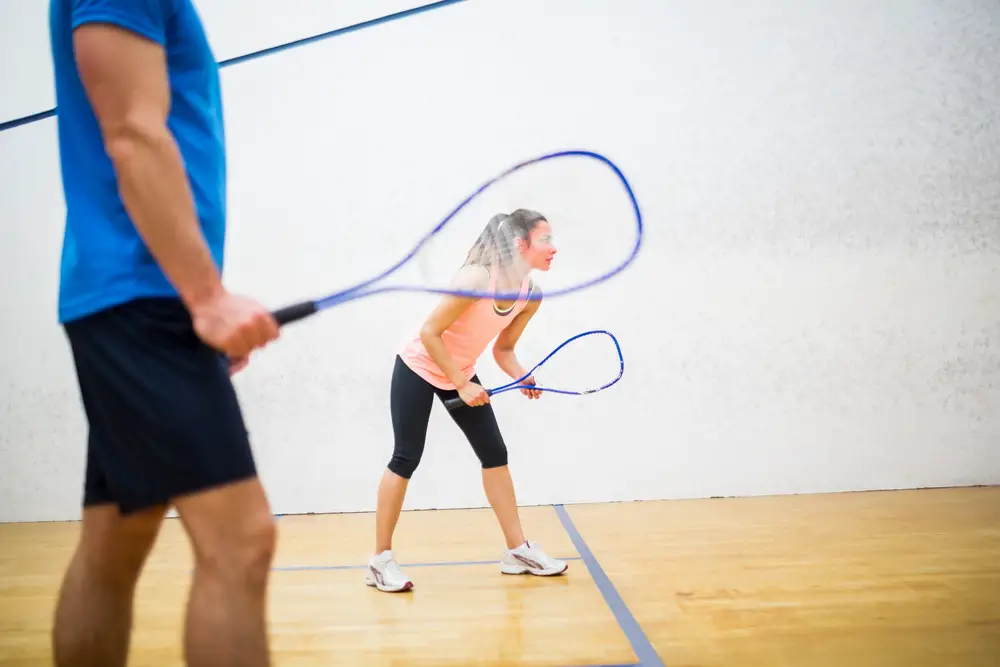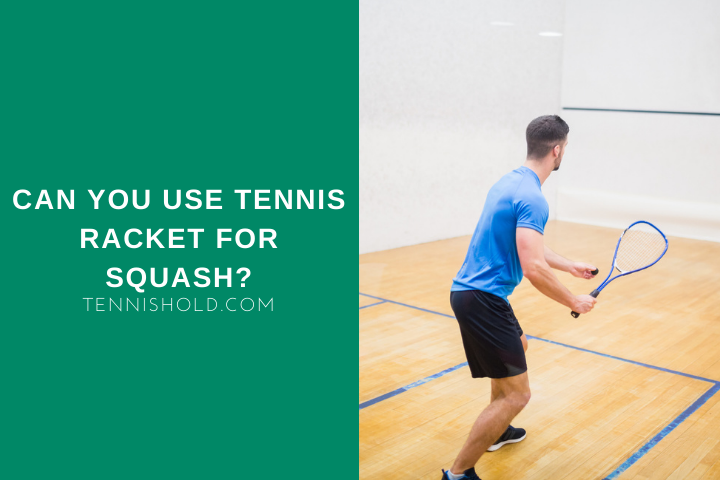Once when I was in my twenties, a friend invited me to play squash against him. Naturally, I accepted his invitation right away.
It couldn’t be challenging to handle a squash racket for somebody like me who had been playing tennis for their whole life.
My view was completely wrong then. Even though squash and tennis are usually put into the same basket of racket sports, they aren’t alike.
And it’s not about the ball or the court proportions as I thought. It is all about the racket.
You can’t use a tennis racket to play squash. If you try it, you risk a serious injury. Tennis rackets are at least twice as heavy as squash rackets. Because of that, using a tennis racket in squash is also illegal, according to game rules.
It’s better to rent or buy a cheap squash racket at the beginning. You won’t spend much money on it, but your wrists and arms will be safe.
If eventually, you find out that squash isn’t what you really enjoy, you can just resell your racket.
Anyway, every time you start something new in your life, put some effort to learn the basics about it. You will get better quicker, commit more, and have lots of fun.
Squash vs Tennis Rackets: Key Differences

When you visually compare a tennis racket with a squash racket, you might judge there isn’t much difference.
Well, imagine you go to a car dealer. Say you want to buy a Mercedes. You look at A-class and C-class on display. Both are driveable, secure, and look impressive. But each one offers diverse parameters and performance.
Now take a look at key differences between tennis and squash racket for better understanding.
| Racket | Tennis | Squash |
|---|---|---|
| Length | Up to 29 inches | Up to 27 inches |
| Width | Up to 12.5 inches | Up to 8.5 inches |
| Head Shape | Elliptical | Teardrop or Oval |
| Weight | 9.8 – 10.9 oz | 3 – 5.3 oz |
| Strings Tension | 45 – 60 lbs | 25 – 35 lbs |
As you can notice, a tennis racket is much bigger and heavier than a squash racket. It’s simply caused by a more demanding on-court situation.
Tennis players have to cover a larger court and reach further during rallies. Their rackets deal with greater ball mass and transfer more power on strokes.
Meanwhile, smaller and lighter squash rackets are way more maneuverable. Their design is a technological answer to the requirements of such a high pace game.
Lesser strings tension and specific racket shape make producing lightning-fast shots easy.
Why Are Tennis Rackets Not Suitable For Squash?

Decode the racket names logically. A tennis racket has been made to play tennis. A squash racket has been made to play squash.
Less ironically, tennis rackets are not suitable for squash because they are disproportionate to this game.
There is no need for equipment like that exaggerated in relation to the ball, court, and playing technique.
Squash requires players to be quick in motion and reaction. Their shot efficiency relies on flickering the wrist rapidly, so the racket has to be very light.
A tennis racket is definitely not. On average, it weighs 2.5 times as much as a squash racket.
The string tension plays an important role as well. Tennis stringbed is hard, often reaching 60 lbs and more. If you hit a squash ball with a ‘board’ like that, it will go powerless. Squash rackets are strung with two times less force to keep the balance between control and power.
But, in case you somehow manage to play squash with a tennis racket, your technique would rather be all downhill. Bad habits occur from the beginning whenever something’s wrong.
The racket feels so heavy, so you subconsciously adjust your technique at the cost of health or added effort.
This, in a short time, can discourage you from participating in physical activity. After all, I don’t know anybody who would stick to anything extra difficult and joyless.
Especially, you have to bear in mind children. They don’t need much of a reason to quit.
Risk Of Injury
The most important cause for not using tennis rackets to play squash is a high risk of injury.
You may find it destructive for your wrist. In a longer perspective, though, your forearm muscles could start hurting because of excessive loading.
As I mentioned before, the proper squash technique is based on whipping. You can’t do that with a tennis racket because it’s just too heavy.
Your swing wouldn’t ever be fine enough. So then why make things more complicated than they really are?
You must remember that there is another player next to you on the court.
You both move rapidly, surrounded by walls, and hit without a flick. A larger and heavier racket, like a tennis one, would only favor close hazardous contacts.
This is the shortest way to needless bruises or skin scrapes.
Fast Exhaustion
OK, if you really want to try it, grab a tennis racket and play squash. I’m not a very strong man to challenge myself this way, but maybe you are.
Some people are lucky to never get injured. But everyone gets exhausted at some point.
If you stick to proper or nearly proper squash technique and decide to play a regular match, I can bet your forearm will be burning soon.
To see the real difference, simply use a squash racket in the first set and then switch it to a tennis racket in the second set.
Don’t be surprised or ashamed to return to the squash racket immediately and for life.
Final Words
I hope that now you understand why each racket sport has its own dedicated equipment.
It’s not because of promotional or economic purposes. On the contrary, tennis, squash, and other rackets were invented and developed for the needs and due to the character of a given sport.
You may attempt to replace some gear with another one to save money and time. There is nothing terrible about it.
Be aware that one day you will need to play with what is meant to. Unless you don’t care about your progression and, more importantly, your wellbeing.
Although tennis rackets are similar to squash or badminton rackets, don’t confuse them all.
Technology advanced so much that each frame inch takes part in increasing performance on the contact with a ball. The right ball only.
If you hit the wrong ball, your racket loses its ‘performance value.’
Do you enjoy competing while being limited by yourself?
Why do you think people came up with an idea to play squash with a tennis racket?

